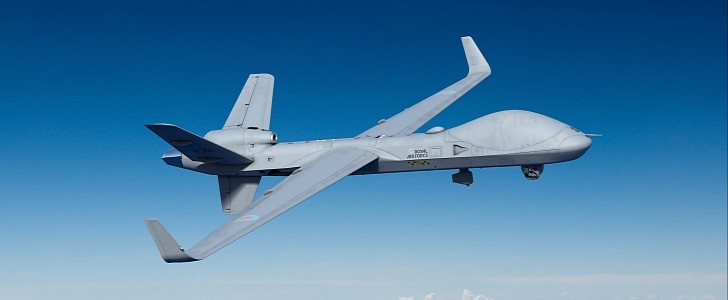Experts from both the U.S. and the UK have contributed to bringing the innovative MQ-9B, also known as the SkyGuardian, to life. Manufactured in California by General Atomics Aeronautical Systems (GA-ASI), the powerful aircraft will boast a V-tail developed by GKN Aerospace in Cowes, England.
The two companies have been partners for more than a decade, first for the MQ-9A and now for the MQ-9B. They recently hit a milestone with the first UK-manufactured V-tail to be installed onto a SkyGuardian RPA (remotely piloted aircraft) that will be delivered to the Royal Air Force (RAF). This is the first of the 16 new aircraft that will enter service with RAF as the Protector fleet.
The new Protector aircraft will boost RAF’s capabilities when it comes to Intelligence, Surveillance, Targeting, and Reconnaissance (ISTAR) operations. But it’s also meant to comply with stringent NATO and UK safety requirements, which means that it can also operate in civilian airspace. According to RAF, Protector could also conduct, when needed, disaster response operations or search-and-rescue missions.
The MQ-9B will also operate in Australia and in Belgium, and all the aircraft variants sold in different parts of the world will be fitted with the V-tails manufactured by GKN Aerospace.
At the beginning of their collaboration, the UK-based aviation company designed and built a “fit and forget” fuel bladder system for the remotely-piloted aircraft. Today, GKN Aerospace produces a wide range of components for GA-ASI’s Predator, including the V-tail, fuel bladders, and a lightweight landing gear system.
The MQ-9B combines a highly-modular platform with the ability to carry multiple mission payloads and with a state-of-the-art Detect and Avoid (DAA) system. With a wingspan of 79 feet (24 meters) and a fuel capacity of 6,000 lb (2,721 kg), this remotely-piloted aircraft can stay in the sky for up to 40 hours, boasting a maximum speed of 210 knots (242 mph/388 kph).
Protector is set to kick off operations in the UK by mid-2024.
The new Protector aircraft will boost RAF’s capabilities when it comes to Intelligence, Surveillance, Targeting, and Reconnaissance (ISTAR) operations. But it’s also meant to comply with stringent NATO and UK safety requirements, which means that it can also operate in civilian airspace. According to RAF, Protector could also conduct, when needed, disaster response operations or search-and-rescue missions.
The MQ-9B will also operate in Australia and in Belgium, and all the aircraft variants sold in different parts of the world will be fitted with the V-tails manufactured by GKN Aerospace.
At the beginning of their collaboration, the UK-based aviation company designed and built a “fit and forget” fuel bladder system for the remotely-piloted aircraft. Today, GKN Aerospace produces a wide range of components for GA-ASI’s Predator, including the V-tail, fuel bladders, and a lightweight landing gear system.
The MQ-9B combines a highly-modular platform with the ability to carry multiple mission payloads and with a state-of-the-art Detect and Avoid (DAA) system. With a wingspan of 79 feet (24 meters) and a fuel capacity of 6,000 lb (2,721 kg), this remotely-piloted aircraft can stay in the sky for up to 40 hours, boasting a maximum speed of 210 knots (242 mph/388 kph).
Protector is set to kick off operations in the UK by mid-2024.







